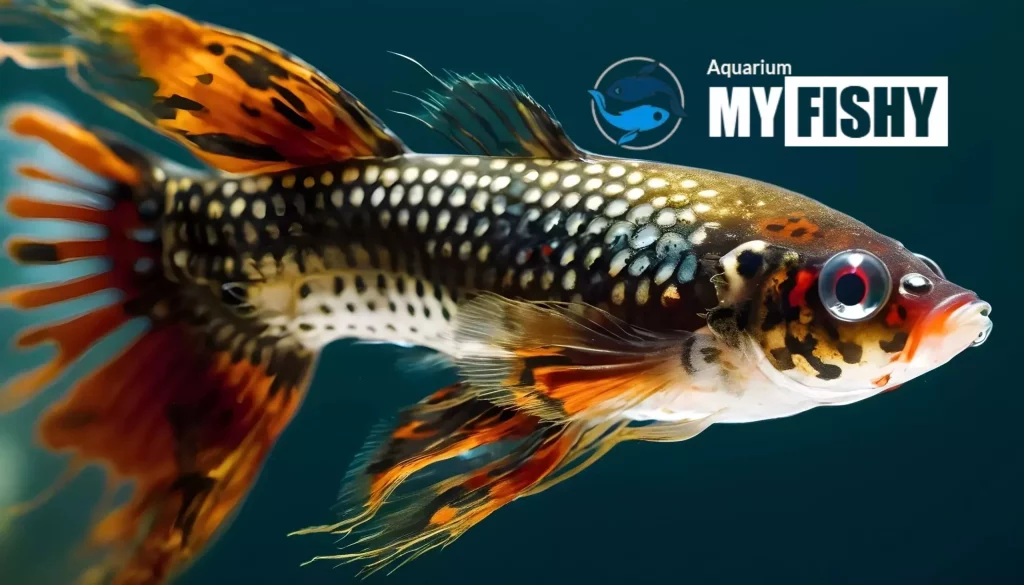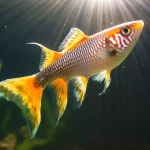Guppies, also known as million fish, are popular pet fish known for their bright colors and friendly nature. They are great for both new and experienced fish keepers because they are resilient and adaptable.
Guppies are generally tough and don’t often get sick compared to other types of fish. Their health can be affected by parasites, bacteria, or viruses. It’s important for those taking care of guppies to be able to recognize signs of illnesses and know how to treat them.
In this guide, we’ll talk about common diseases that affect guppies, including their symptoms, causes, and how to cure them.
It’s important to understand these common health issues so we can make sure our pet guppies’ live happy and healthy lives with the love and care they deserve.
20 Common Guppies Diseases: What Every Fish Keeper Should Know
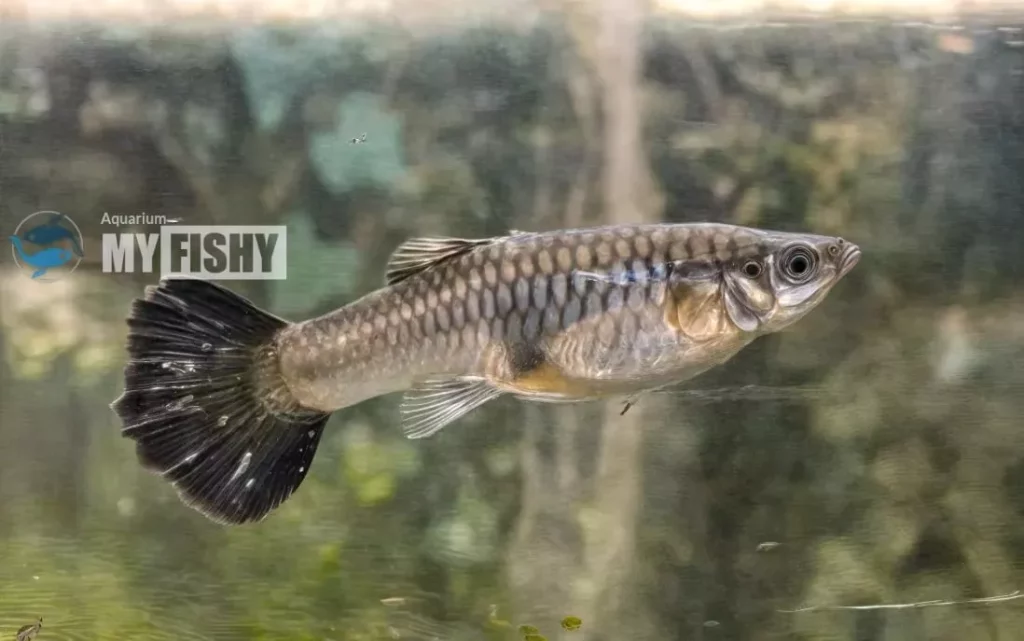
1. White Spot Disease/Ich in Guppies:
White Spot Disease, also known as Ich, is a common disease in guppies caused by a parasite called Ichthyophthirius Multifilis. This parasite creates cysts on the fish’s skin, leading to white spots on fins and body.
Causes:
- Poor water quality (high nitrite, nitrate, and ammonia levels).
- Overpopulation, inadequate nutrition, or sudden changes in temperature or water chemistry.
- Death may occur in extreme situations.
Symptoms:
- Tiny white dots on fins and body.
- Loss of appetite.
- Rapid breathing.
- Fatigue.
- Redness on body and fins.
Treatment:
- Raise water temperature to 80 degrees slowly (one degree per day) to speed up parasite life cycle.
- Use prescribed medication (e.g., Malachite Green and Formalin) to control the parasite.
- Add one teaspoon of aquarium salt per gallon for 4-7 days in both the main and hospital tanks.
- Perform a grander water change (70%) to remove parasites, and vacuum substrate to eliminate eggs.
Prevention:
- Maintain consistent water temperature and pH.
- Regularly clean the tank.
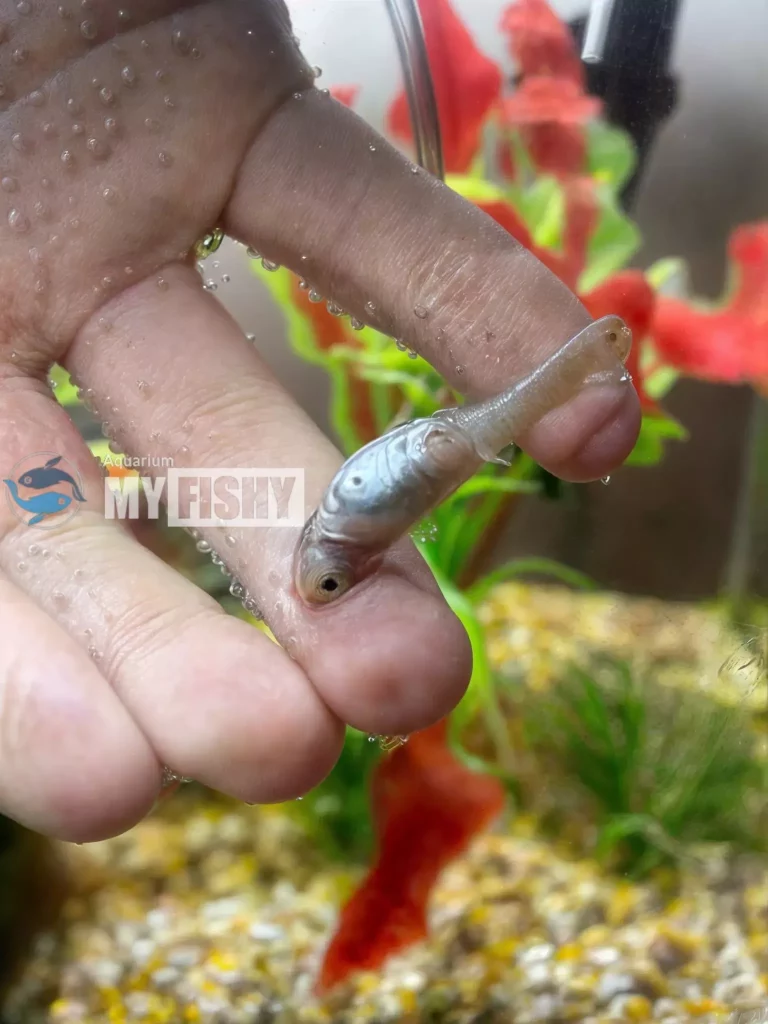
2. Swim Bladder Disorder in Guppies:
Guppies, like other fish, have a swim bladder for buoyancy, filled with gas for balance while swimming. Swim Bladder Disorder is a common issue in guppies that affects the swim bladder, a sac that helps them stays floating.
Causes:
- Overeating.
- Constipation.
- Biological abnormalities.
- Physical harm.
- Exposure to pesticides or harmful substances.
- Certain pathogens or microbes.
- Low water temperature.
- Pregnancy.
Symptoms:
- Difficulty swimming.
- Floating at the top or sinking to the tank’s bottom.
- Incoordination or a fractured spine.
- Trouble staying straight.
- Balance issues.
- Reduced appetite.
- Lethargy.
- Abdominal swelling.
Treatment:
- Reduce the amount of feeding.
- Use a constipation remedy if overeating or constipation is the problem.
- If a bacterial infection is the cause, use antibiotics.
- Provide balanced nutrition and maintain good tank hygiene practices.
Prevention
- Keep the tank temperature between 78 to 80 degrees F.
- Perform 70% water changes to improve water quality.
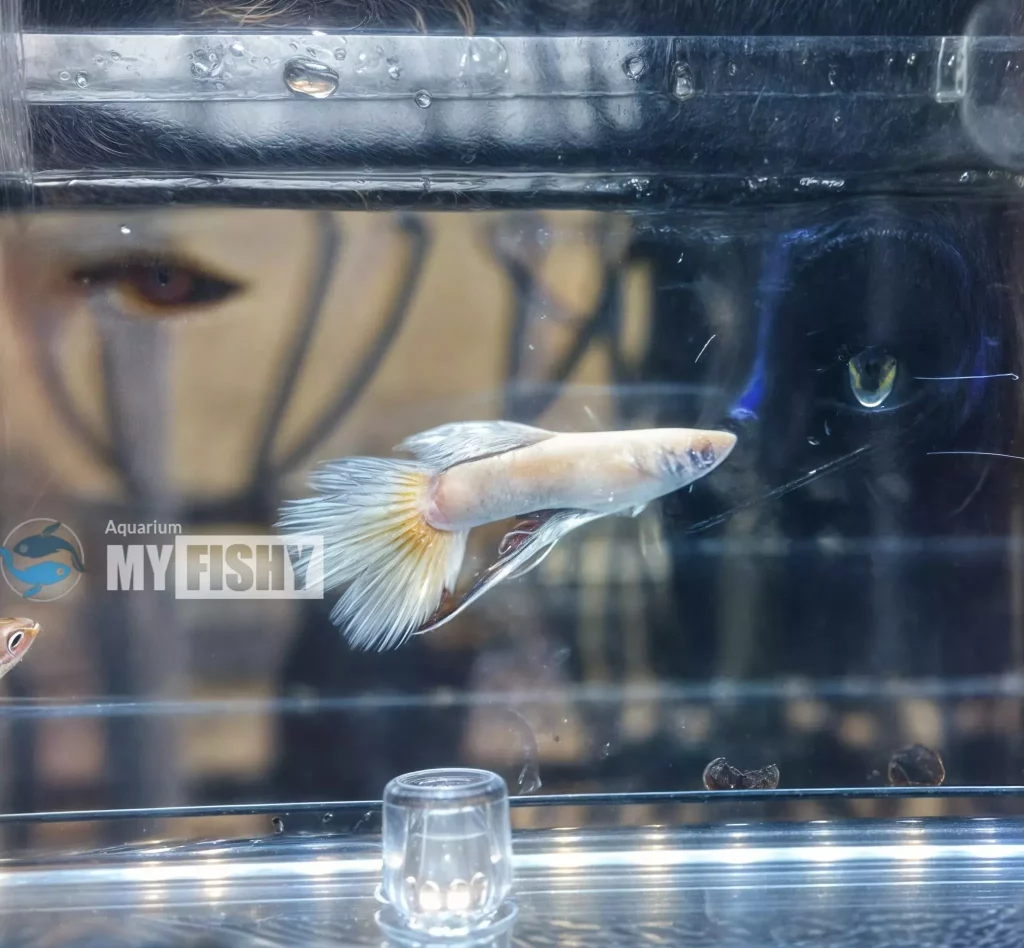
3. Fin and Tail Rot in Guppies:
Fin and Tail Rot is a common problem in guppies caused by a microbial infection. It’s often due to poor water quality, injuries, inadequate nutrition, or weakened immune systems.
Causes:
Poor water quality with high nitrite, nitrate, and ammonia levels.
Physical injuries to fins.
Inadequate nutrition or underlying health issues.
Symptoms:
- Damaged tails and fins.
- Discoloration.
- Tissue deterioration.
- Tattered and flaked fins and tail.
- Fins with faded or rotted ends.
Treatment:
- Move the sick fish to a separate tank to prevent spreading the infection.
- Administer antibiotics like Maracyn, Kanamycin, or Tetracycline to eliminate bacterial infection.
- Consider using specific medications for fin rot, such as Jungle Fungus Clear.
- Ensure the tank has high-quality water if rotting is due to ammonia burns.
- Use bathing techniques to help the fish relax and de-stress.
Prevention:
- Avoid housing guppies with aggressive fish like barbs, bettas, angels, and gouramis.
- Avoid overcrowding the tank.
- Practice good tank habits for cleanliness.
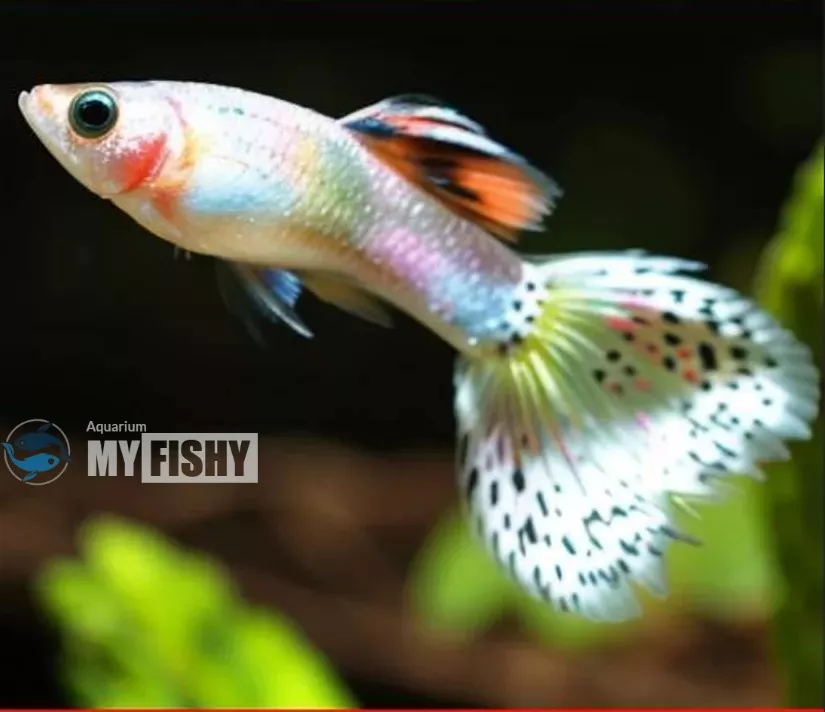
4. Swollen Gills in Guppies:
Guppies breathe through their gills, a sensitive organ similar to human lungs. High ammonia levels in tank water can harm the gills and make their gills swells, causing them to gasp for air.
Causes:
Ammonia, a toxic chemical from decomposing fish food, waste, dead fish, and organic matter.
- Symptoms:
- Gasping for air.
- Swollen gills.
Treatment:
- Perform a 50% water change to reduce ammonia levels in the aquarium.
- Stop daily feeds for a few days to control ammonia buildup.
- Test ammonia levels for the next five days to monitor improvement.
- Introduce nitrifying bacteria to help break down and remove ammonia.
Prevention:
- Change half of the water in the tank.
- Add bacteria to break down ammonia and keep your guppies healthy.
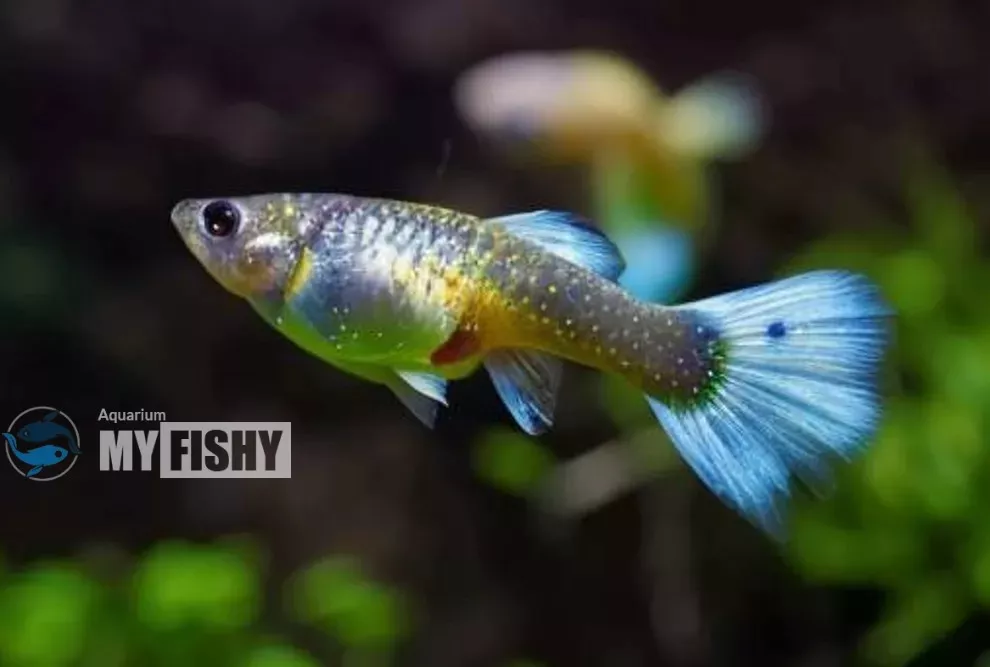
5. Velvet (Oodinium) in Guppies:
Velvet is caused by the parasitic organism Oodinium pilularis, commonly found in freshwater tanks. This parasite can harm fish with existing health issues or in poor living conditions.
Causes:
- Poor water quality.
- High temperatures.
- Excessive fish numbers.
- Contaminated fish or live food.
Symptoms:
- Golden or rusty sheen on body, fins, and gills.
- Difficulty swimming.
- Lethargy.
- Loss of appetite.
- Rubbing against surfaces.
- Twisted fins.
Treatment:
- Use specific medications like CopperSafe, or a combination of Formalin and Malachite Green.
- Consider using a UV sterilizer to kill parasites in the water.
- Improve water conditions with regular water changes.
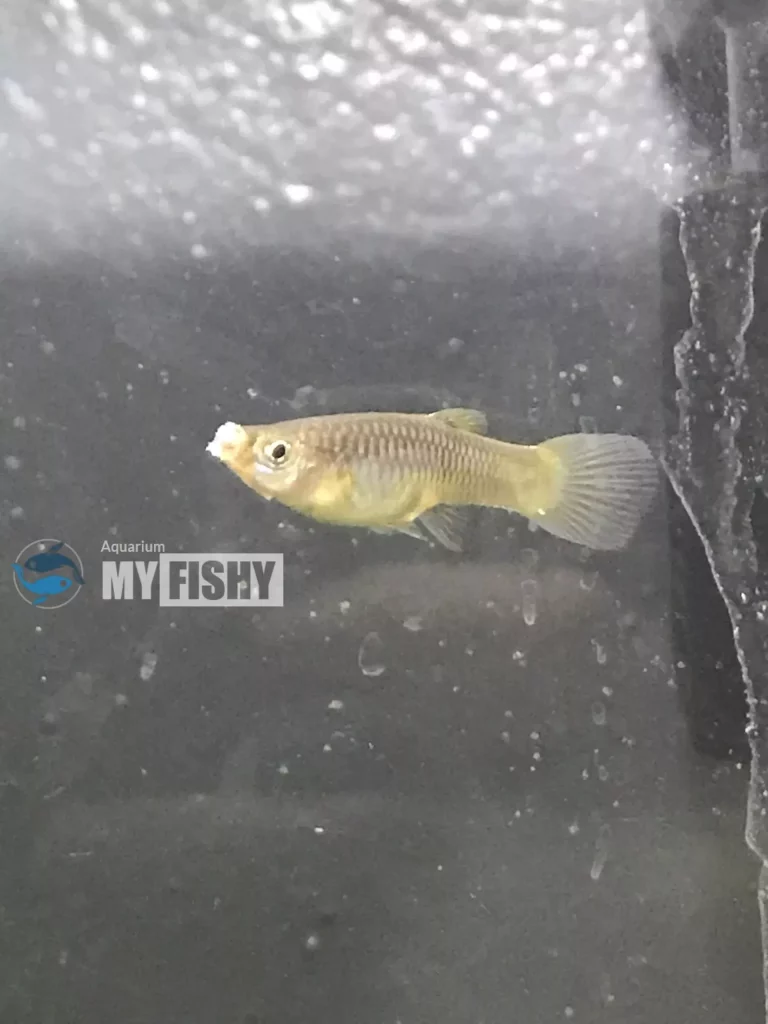
6. Columnaris & Mouth Fungus in Guppies:
Columnaris is caused by the Flexibacter columnaris parasite, while Mouth Fungus is caused by the fungal pathogen Saprolegnia. Both diseases thrive in poor water conditions and stress.
Symptoms:
- White or grey ulcerations on the body, fins, and head.
- Difficulty swimming.
- Skin irritation with white cotton-like cysts on lips, gills, and fins.
- Eating disorders.
Treatment:
- Add an air stone or power head for better oxygenation.
- Use a water conditioner to detoxify the water.
- Keep the tank clean and debris-free.
- Avoid overcrowding and overfeeding.
- Consider using a UV sterilizer to eliminate bacteria in the water.
- Use 3 tsp of aquarium salt for 1 gallon of water daily for three days.
- Include a 30-minute medicine bath.
- Ensure guppies get enough minerals.
- Perform regular water changes and maintain tank hygiene.
Prevention:
- Keep an appropriate number of guppies for your tank size.
- Ensure proper filtration, regular water changes, and good ventilation.
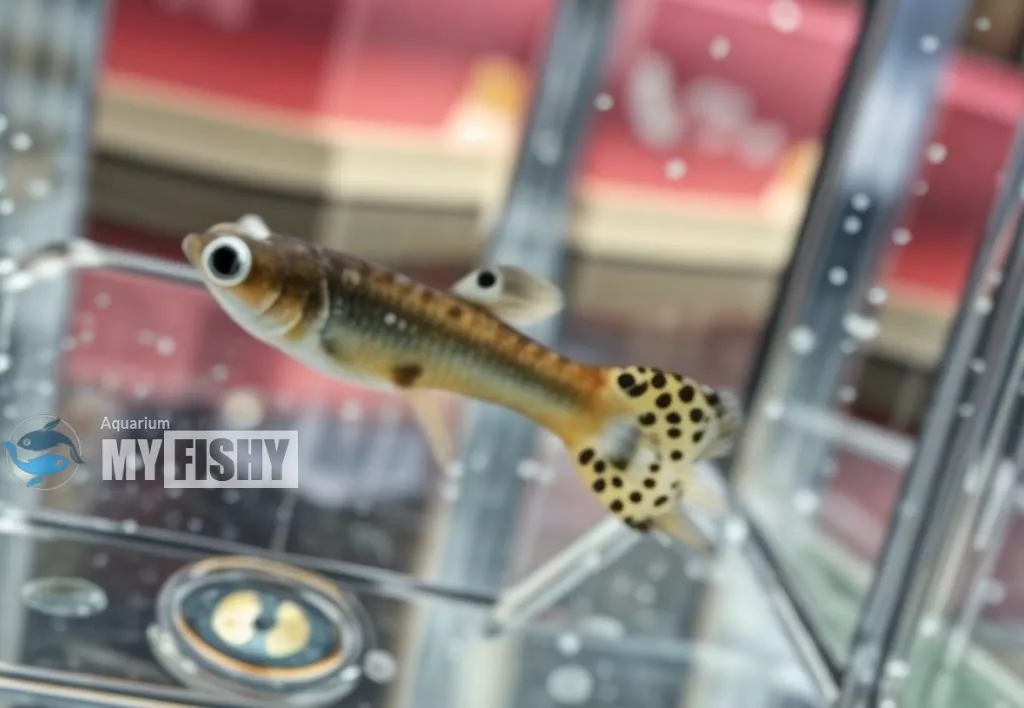
7. Popped Eyes (Popeye) in Guppies:
Popped Eyes, or Popeye, is a disorder where one or both fish eyes protrude from their sockets.
Causes:
- Bacterial infections.
- Physical trauma.
- Dietary imbalances.
- Pollutants.
- Chemicals.
- Weak immune systems.
Symptoms:
- One or both eyeballs protruding.
- Hazy or yellowish damaged eye.
- Irritation or infection around the eye.
- Hypersensitivity to light.
- Eye dryness or leakage.
- Iris color transition.
- Visual impairment.
Treatment:
- Use antibiotics like erythromycin to treat bacterial infections.
- Ensure a diet rich in vitamin A for good nutrition.
- Isolate the affected fish to prevent the spread of the virus to other fish.
- Administer medicine to treat parasite infections.
- If caused by physical injury, surgery may be necessary.
Prevention:
- Maintain good water quality.
- Be cautious with fish handling to prevent injuries.
- Provide a well-balanced diet.
- Keep the tank environment clean.
- Regularly monitor your guppies’ health.
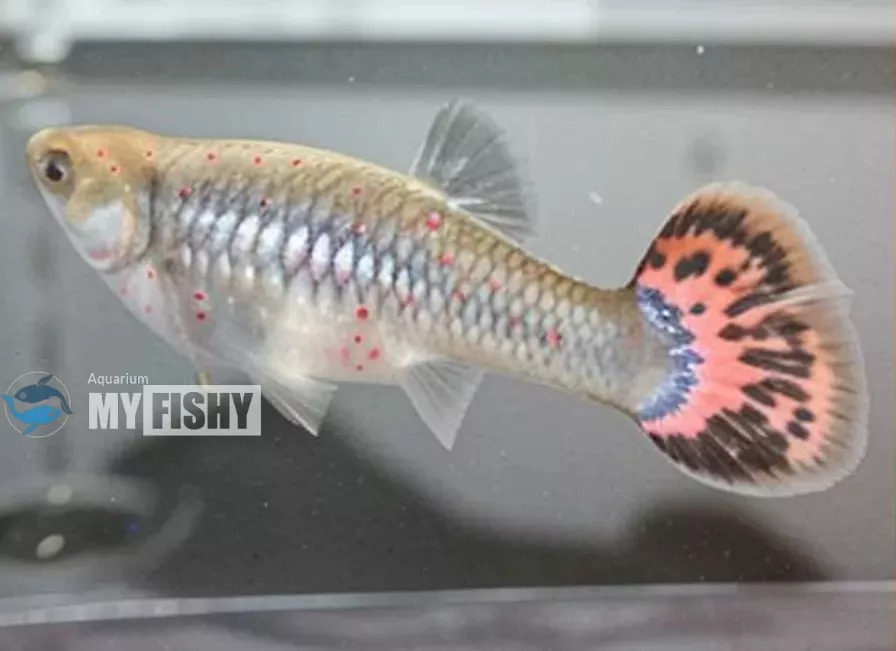
8. Red Blood Spot (Hemorrhagic Septicemia) in Guppies:
Red Blood Spot, or Hemorrhagic Septicemia, is a microbial disease caused by the gram-negative microorganism Aeromonas hydrophila. It is identified by red or purple markings on the body, fins, and tails of guppies.
Red Blood Spot disease is linked to ammonia poisoning, and prevention involves establishing a healthy, cycled aquarium environment before adding fish.
Symptoms:
- Red and purple markings.
- Difficulty swimming.
- Internal bleeding on gills, tail, and spine.
- Skin discoloration.
Treatment:
- Change water regularly to improve water quality.
- Check acidity, nitrate, phosphorous, and ammonium concentrations within guppies’ normal limits.
- Keep an eye on parameters like pH, hardness, and chlorine; adjust if necessary.
Prevention:
- Cycle the aquarium for two weeks to establish beneficial bacteria.
- Allow beneficial bacteria to grow for 6-8 weeks.
- Test for 0 ppm ammonia and nitrites before introducing fish.
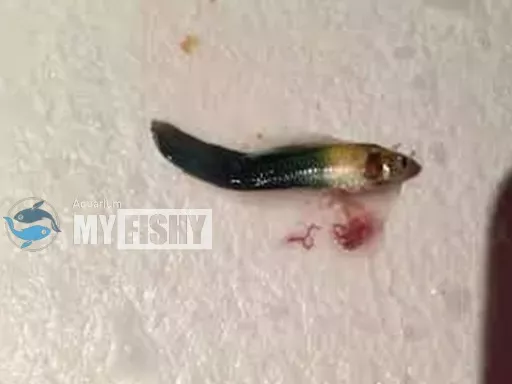
9. Camallanus Internal Worm in Guppies:
Camallanus internal worm is caused by a nematode worm called Camallanus cotti. Fish get infected by consuming the infective phase present in living food or the environment.
Causes:
- Bad water quality.
- Overfeeding.
- Overstocking can increase vulnerability.
Symptoms:
- Red worm-like outgrowth from the fish’s rectum.
- Inability to eat.
- Weight reduction.
- Bloating.
- Reduced activity.
Treatment:
- Use medications like Levamisole, Praziquantel, or Fenbendazole as prescribed by a vet.
- Change tank water once a week.
- Feed medicated food or use medicated feed to treat the fish.
Prevention:
- Outdoor and those feeding on live cyclops are more susceptible.
- After the treatment period, clean the filter, vacuum the substrate, and perform a 70-90% water change. Repeat after three weeks.
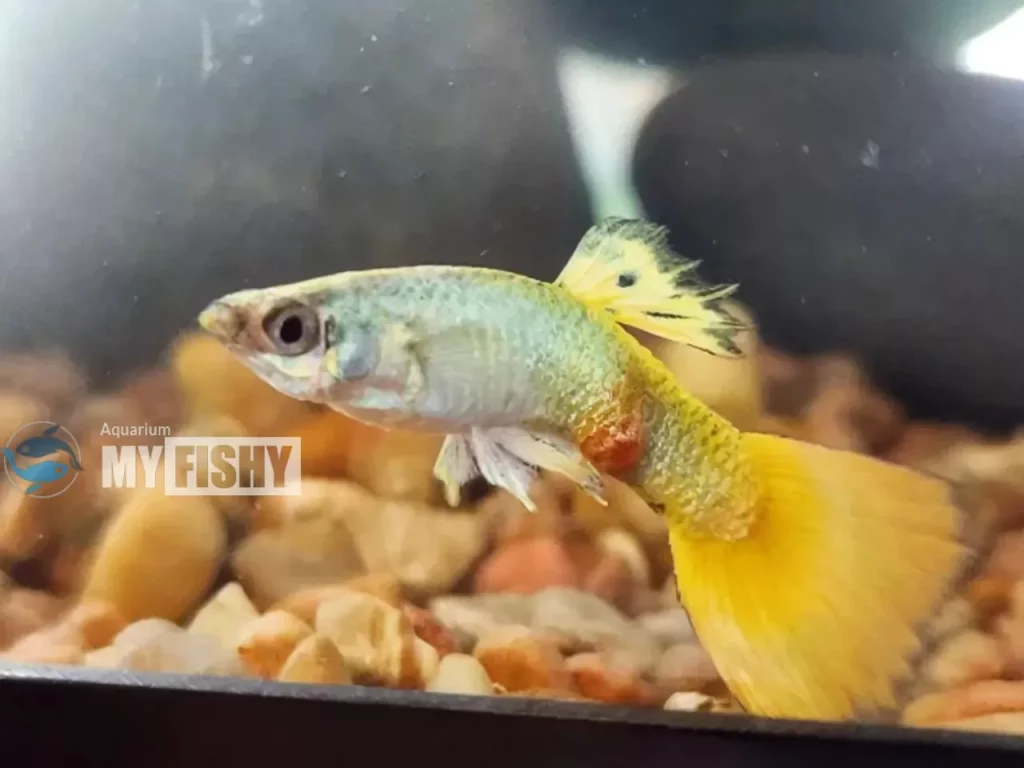
10. Viral Hemorrhagic Septicemia (VHS) in Guppies:
Viral Hemorrhagic Septicemia (VHS) is a highly infectious and life-threatening illness that can impact various fish species, including guppies. The virus is primarily transmitted through water, contaminating fish and fish items. Fish may be more vulnerable to VHS if they are stressed, exposed to wild aquatic animals, or in unsuitable water temperatures.
Symptoms:
- Hemorrhaging on gills, tail, and spine.
- Inflammation in the head, cornea, and spine.
- Skin hyperpigmentation.
- Loss of appetite.
Treatment:
- Isolate the affected fish immediately.
- Disinfect the affected tank and equipment.
- Ensure tank conditions are suitable for guppies.
- Prevent overcrowding and minimize stress to fish.
- Observe fish closely and quarantine new fish before introducing them to a healthy tank.
- Perform a 70% water change after the treatment period.
- Maracyn is the only proven effective antibiotic for VHS.
Note: VHS is a serious viral infection, and treatment with the appropriate antibiotic is crucial. Consultation with a vet is recommended for accurate diagnosis and treatment.
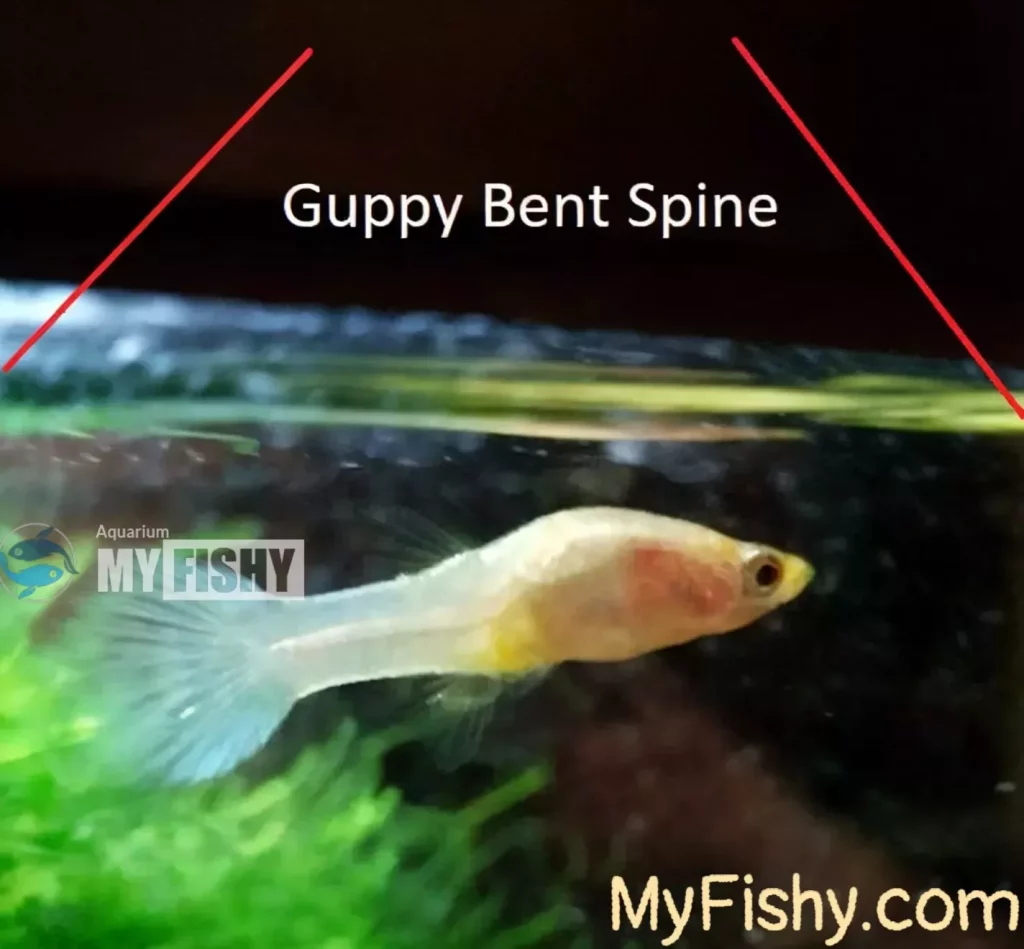
11. Scoliosis (Bent Spine) in Guppies:
Scoliosis, or Bent Spine, is a hereditary condition where the animal’s spine bends in one direction. It can be hereditary or caused by dietary deficiencies in calcium and vitamin D3, as well as harsh tank conditions.
Symptoms:
- Clearly evident spinal curve.
- Difficulty swimming.
- Decreased mobility.
Treatment:
- Provide a balanced diet rich in calcium and vitamin D3.
- Maintain good tank conditions.
Note: Scoliosis is not contagious but inherited. Unfortunately, there’s limited treatment, and providing a healthy diet and proper tank care is essential. Fish with bent spines may have a shorter lifespan.
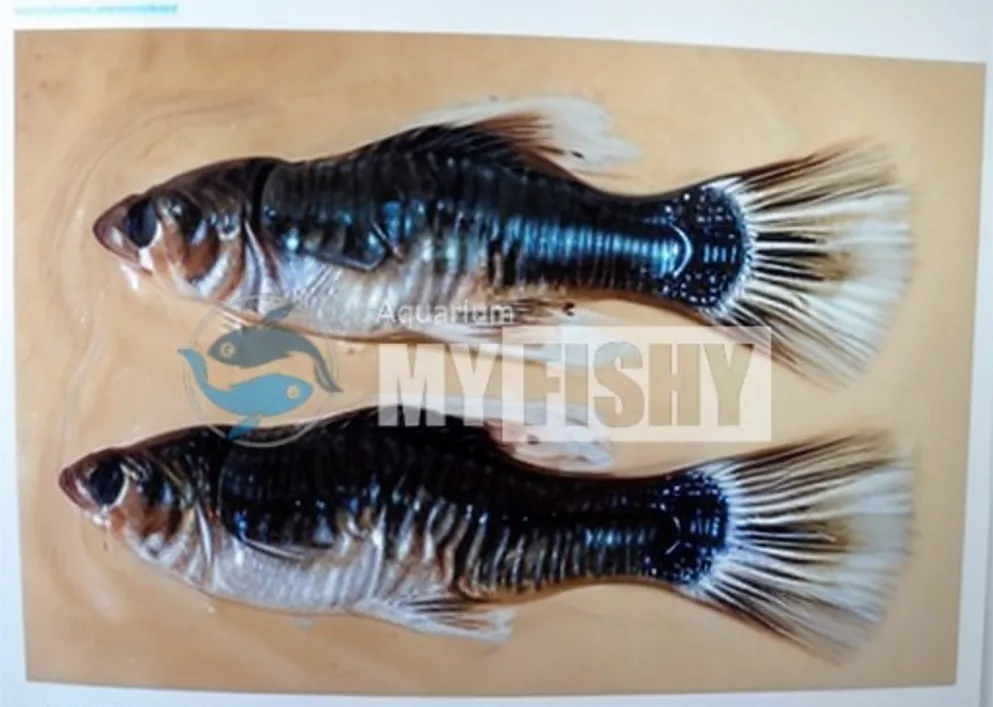
12. Fish Tuberculosis (Mycobacteriosis) in Guppies:
Fish Tuberculosis, or Mycobacteriosis, is caused by Mycobacterium organisms and can be transmitted through encounters with polluted water, animals, or supplies. It enters a tank through diseased wild fish or by ingesting sick dead animals.
Symptoms:
- Scars, blisters, and reddening on the fish.
- Skin discoloration.
- Diarrhea.
- Small bumps or pustules on the body and tail.
Treatment:
- Remove the affected fish immediately.
- Clean the impacted aquarium and tools.
- Ensure a healthy tank environment.
- Treat with Neomycin, Kanamycin, or Isoniazid antibiotics.
Note: Fish tuberculosis is contagious and can cause various symptoms in guppies. While treatment focuses on controlling the disease, it’s crucial to follow the steps and consult with a vet. Additionally, be cautious as humans can get infected, so wear gloves when handling sick fish.
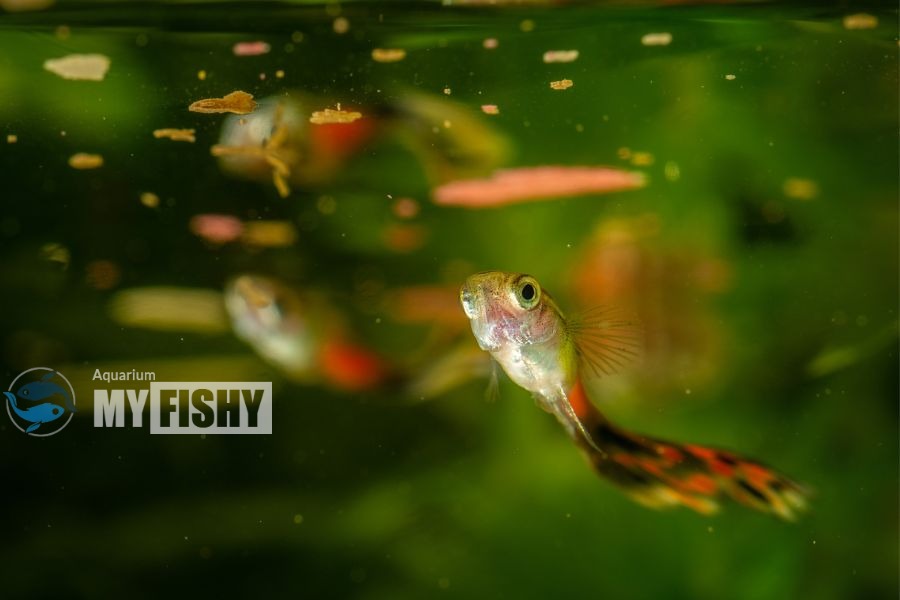
13. Hexamitiasis in Guppies:
Hexamitiasis, commonly called Hexamita, is a pathogenic illness transmitted by the protozoan Hexamita. Poor sanitation, overpopulation, and carbohydrate-rich food can contribute to the illness, primarily affecting the fish’s stomach.
Symptoms:
- Diarrhea.
- Reduced appetite.
- Weight loss.
- Paler skin appearance.
Treatment:
- Change tank water by at least 60-70%.
- Medicate the water with metronidazole or other antiparasitic medications.
- Provide fish with a medicated diet or mix liquid medicine in the tank.
Prevention:
- Avoid overcrowding and maintain regular tank cleaning.
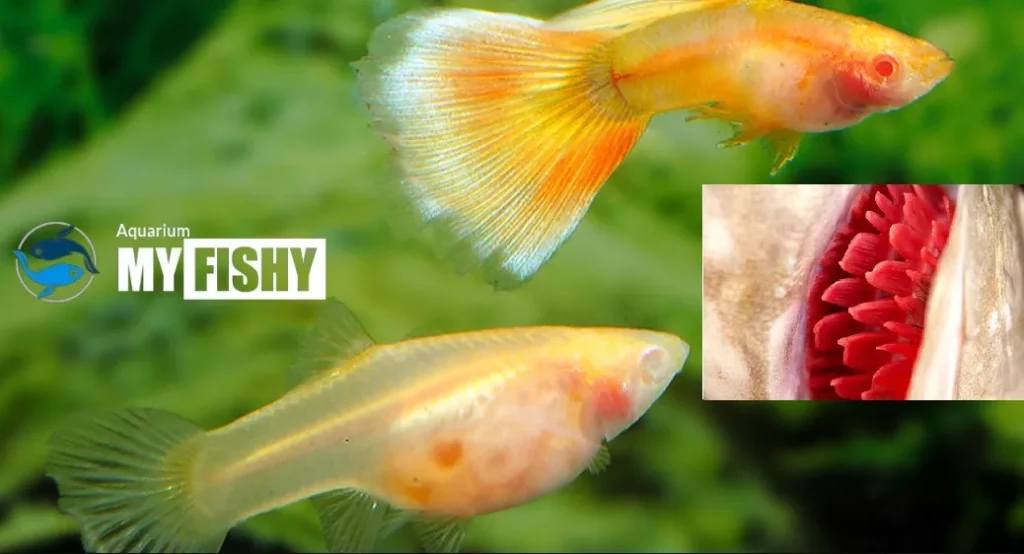
14. Gill Flukes in Guppies:
Gill Flukes are pathogenic flatworms that attack fish gills, causing harm and allergic reactions.
Causes:
- Bad aquarium temperature.
- Overpopulation.
- Introduction to contaminated wild fish.
Symptoms:
- Breathing heavily at the tank surface.
- Tightening of fins.
- Infection and hyperpigmentation of the gills.
- Restricted appetite.
- Overproduction of mucus around the body or gills.
- Tiny blood vessel spots on the body and fins.
Treatment:
- Isolate the affected fish to prevent the spread of the infection.
- Medicate the water with a medication containing praziquantel or other antiparasitic medications.
- Note: Preventive measures include quarantining new fish. Early-stage conditions are treatable, but if gills start bleeding, treatment may be impossible, leading to fatal consequences. Consult with a vet for proper diagnosis and treatment.
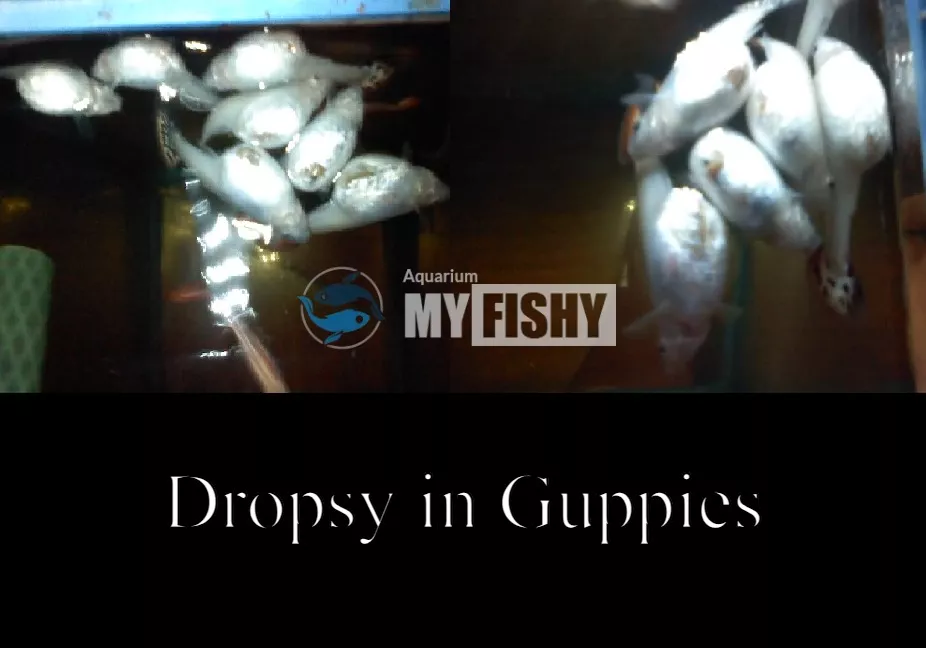
15. Dropsy in Guppies:
Dropsy is a disorder causing the animal’s body to swell with fluid. It can be caused by various factors like respiratory diseases, viral outbreaks, poor tank quality, and internal organ damage.
Symptoms:
- Body soreness.
- Pinecone-shaped scales.
- Appetite loss.
- Drowsiness.
- Bloating.
- Pop-eye.
- Reddish undertones on the fins and body.
- Swimming abnormalities.
Treatment:
- Cannot be treated if a bacterial infection is the primary cause.
- Using 2 tbsp of Epsom salt mixed in 1 gallon of aquarium water may help the affected fish.
Preventions:
- Maintain a clean tank.
- Avoid stress.
- Feed high-quality food.

16. Protozoan Illness in Guppies:
Protozoan illnesses in guppies are caused by various types of unicellular parasites. Parasites can enter through contaminated water, contact with other animals, or consumption of contaminated food. It can also be caused due to poor hygiene practices and low oxygen levels may contribute.
Symptoms:
- Breathing heavily.
- Struggling to breathe at the tank’s surface.
- Abdominal pain and bloating.
- Gas.
- Indigestion.
- Weight loss.
Treatment:
- Use a good quality heating system.
- Malachite Green or Formalin could help in the initial stage.
- In extreme cases, use copper medicine like Seachem Cupramine.
- Keep your tank water clean.
Prevention:
- Maintain good hygiene practices.
- Ensure oxygen levels.
- Provide a clean environment for your guppies.
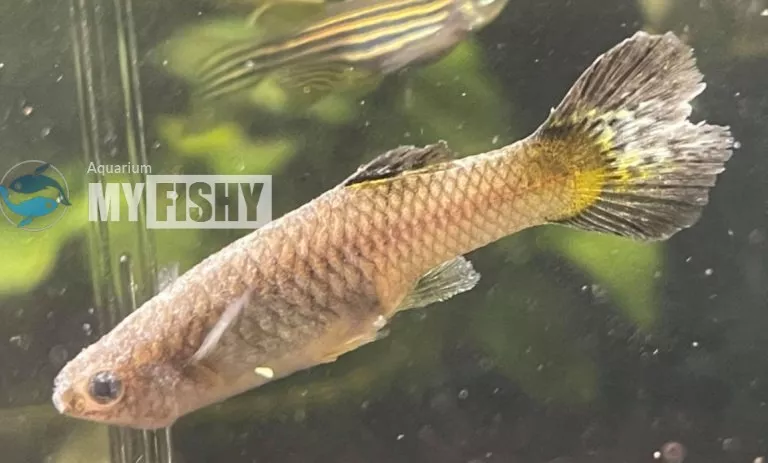
17. Tetrahymena in Guppies:
Tetrahymena is a family of pathogenic multicellular protozoans, mostly affecting guppies. These pear-shaped bloodsuckers have ciliated surfaces, allowing them to travel and consume cellular substances on fish bodies. Guppies are highly vulnerable to Tetrahymena.
Symptoms:
- White markings on sides and tails.
- Twisted fins.
- Low appetite.
- Uncomfortable breathing.
- Fatigue.
Treatment:
- Use formalin or antibiotics containing malachite green and copper.
- Regular monitoring and prompt treatment are essential to manage Tetrahymena occurrences.
Prevention:
- Maintain good tank hygiene.
- Minimize strain on guppies.
- If you notice symptoms, consult with a vet or use appropriate medications to address the issue promptly.
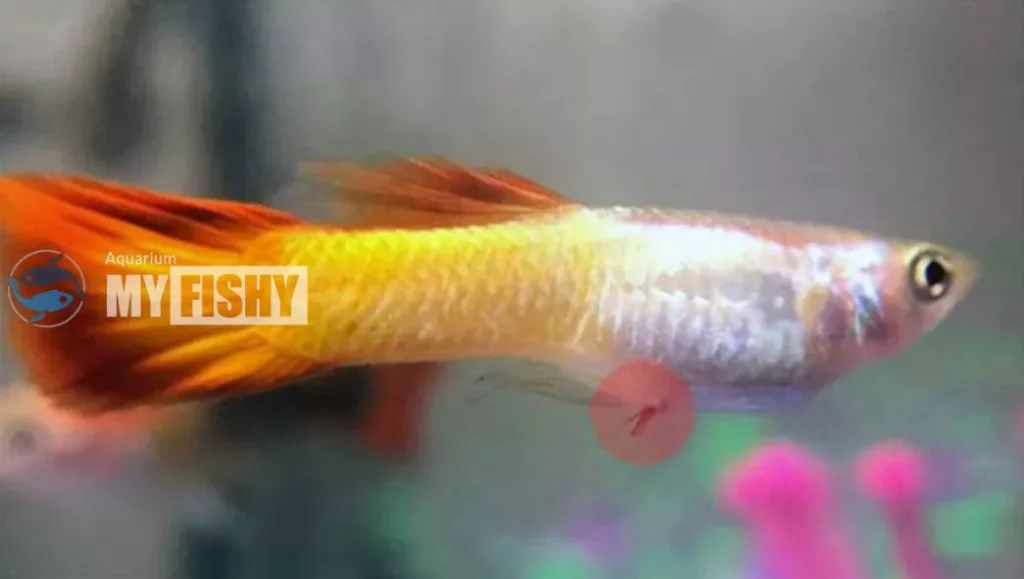
18. Anchor Worms in Guppies:
Anchor worms, are microscopic invertebrates that attack fish. They use a hook-like tip to attach to the fish’s body, usually on the gills or tail and infection occurs through contact with contaminated water or by consuming infected animals or raw food. Anchor worms may also reside in dirt or plants, posing a threat to animals approaching them.
Symptoms:
- Visible parasites clinging to the fish’s body or fins.
- Stroking or brushing against aquarium surfaces.
- Swelling or rashes in the affected area.
Treatment:
- Carefully remove the anchor worm from the fish’s body.
- Apply an antibiotic medication to the affected region.
- Seek advice from your vet for proper medication.
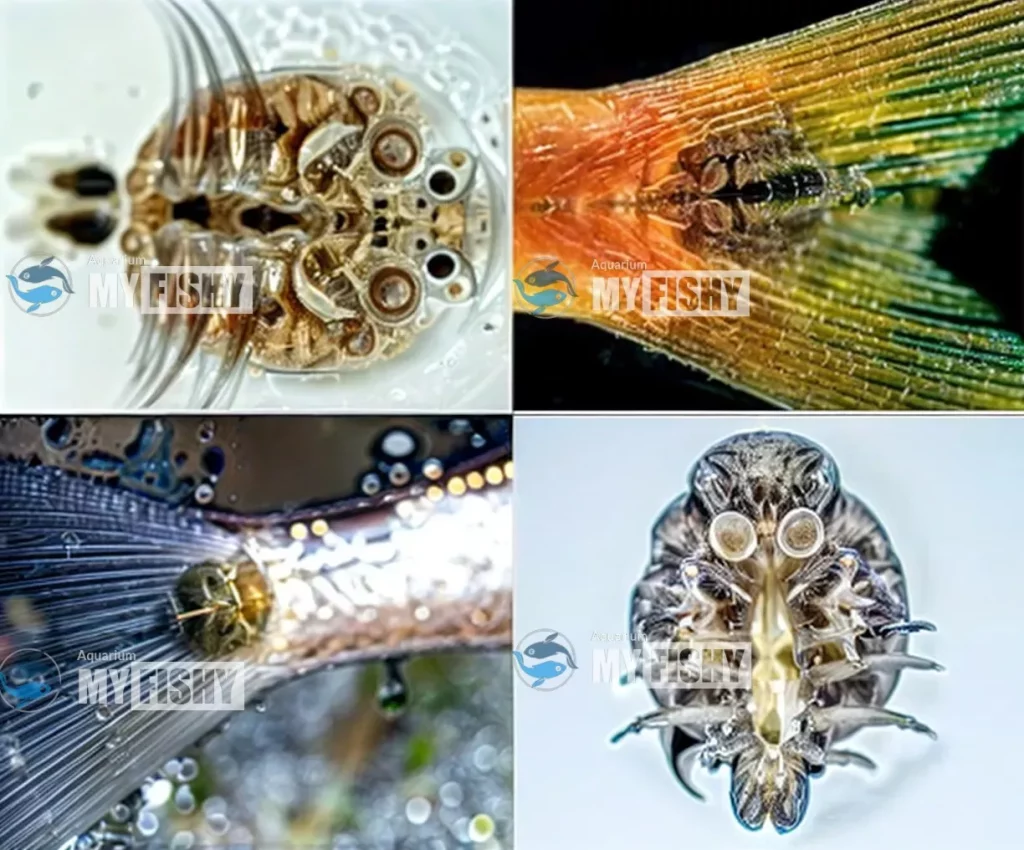
19. Freshwater Fish Lice in Guppies:
Freshwater fish lice are tiny shellfish that attach themselves to fish. They can be found on the fins or skin, using a sucker-like mouth to cling on. Infected fish have a high mortality rate as lice can carry other parasites, leading to dangerous secondary infections. Puncture sites where lice attach can become infected with bacteria or fungi. Outbreaks of fish lice can be a significant problem for freshwater fisheries, leading to season closures.
Symptoms:
- Spots on fish.
- Scratching behavior.
- Inactivity.
- Odd swimming behavior.
Treatment:
- Remove bigger lice from the fish’s body manually.
- Eliminate eggs or larvae present in the aquarium.
- Use low-dose insecticides for a permanent removal of lice.
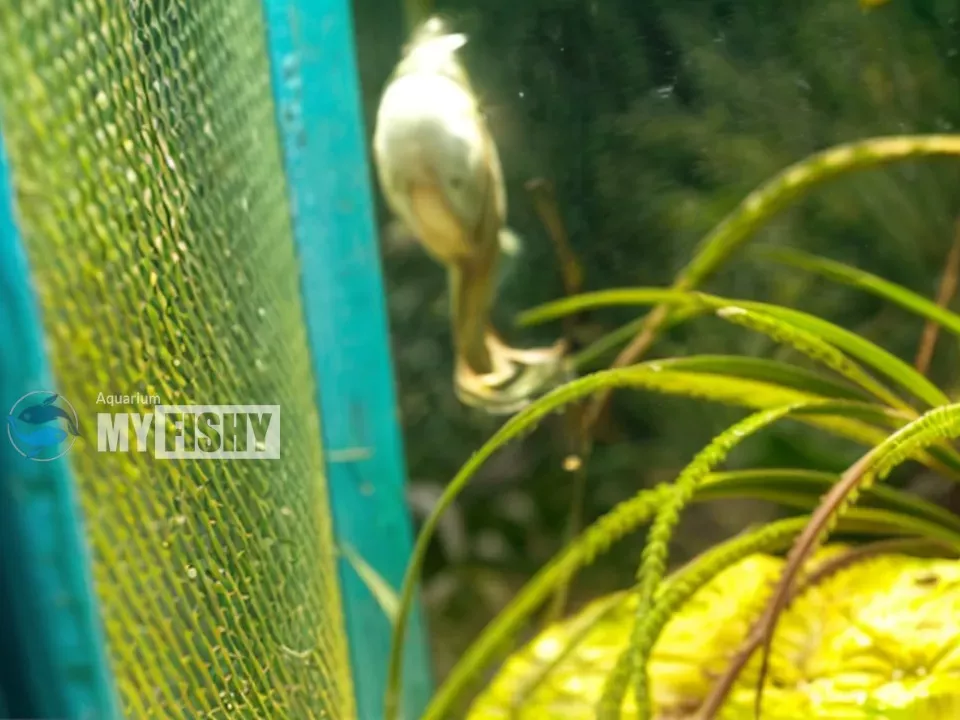
20. Swim Bladder Inflammation in Guppies:
Swim bladder inflammation in guppies shows symptoms like unusual swimming angles and a swollen belly due to a viral infection.
Treatment:
- Unfortunately, swim bladder inflammation is highly infectious and currently has no specific treatment.
- Once a guppy is identified as sick, promptly remove it from the tank to prevent further infections.
Prevention:
- Maintain a clean tank.
- Avoid overcrowding.
- Monitor guppies for any signs of illness.
- If unsure or if the condition continues, consult with a vet for guidance.
Conclusion
In conclusion, being a responsible owner of guppies involves a deep understanding of common diseases they may encounter. By staying informed about symptoms and appropriate treatments, such as maintaining pristine water conditions, providing a well-balanced diet, and avoiding overcrowding, you can significantly contribute to their overall health.
Early detection of any signs of illness is vital, and seeking professional advice from a veterinarian or experienced aquarist when needed ensures prompt and effective care.
Keeping the guppy tank clean and well-maintained not only prevents diseases but also promotes vibrant colors, graceful movements, and a longer, happier life for these delightful aquatic companions. While some guppy diseases are more widespread than others, focusing on preventative measures remains the key to ensuring the well-being of these colorful and charming aquatic pets.
FAQs:
Q: Do guppies frequently suffer from diseases?
A: Guppies are highly inclined to Tetrahymena infections compared to other aquarium fish. It’s extremely important for fish keepers to choose healthy guppies from tanks with no sick fish to prevent the spread of this disease.
Q: Can I Use Salt Baths to Treat Guppy Diseases?
A: Salt baths can be used for some guppy diseases, like Epsom salt baths that may provide relief and delay severe symptoms. However, it’s crucial to consult with a vet or experienced aquarist before attempting this method, as not all diseases respond well to salt baths and improper use may worsen the issue.
Q: What Should I Do if I Think My Guppy Is Sick?
A: If you suspect your guppy is sick, isolate it from other fish and seek advice from a vet or experienced aquarist. Additionally, improve water conditions with regular changes, ensure optimal pH and nutrient levels, and maintain good tank hygiene to support the fish’s recovery.
Q: Are Protozoan Illnesses Common in Guppies?
A: Protozoan illnesses in guppies can result from various unicellular parasites. These parasites can be transmitted through contaminated water, other animals, or contaminated food. Symptoms include breathing difficulties, weight loss, and bloating. Keeping the tank clean and using appropriate medications can help manage these illnesses.
Q: How do I know if my guppy has parasites?
A: If your guppy has parasites, you might see tiny white spots on its fins and skin. These spots are caused by a parasite called ichthyophthirius multifiliis, and it’s quite easy to notice. The parasite lives on the fish’s skin, creating small white cysts. Keep an eye out for these white spots as they indicate the presence of parasites on your guppy.

